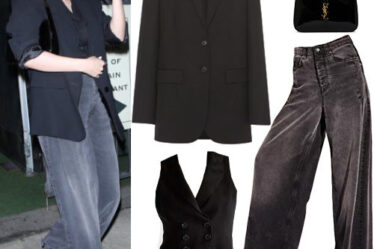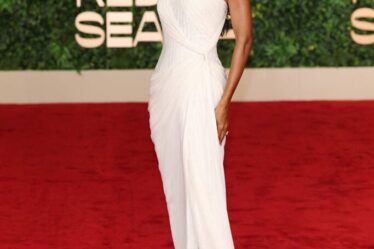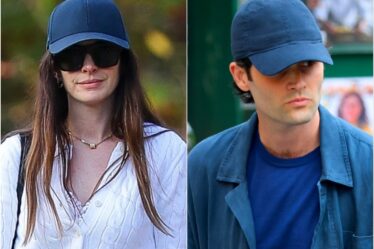
For its Pre-Spring 2024 campaign, Bottega Veneta embraced the everyday.
Called “Readymade” and unveiled Dec. 5, the campaign catalogues mundane, even boring moments in the lives of the very-famous A$AP Rocky and Kendall Jenner, who carry groceries, pump gas, drink lattes and jog in head-to-toe Bottega Veneta.
The images look more like the work of a paparazzi than a fashion photographer — because they are. The pictures used in the campaign were published in the likes of TMZ and People in October, without the Bottega Veneta logo stamped on top of them.
The plan, Rocky explained on Instagram, was to build a campaign centred around the “type of photos taken by candid photographers while I do my everyday thing.”
While surrealist marketing stunts like Jacquemus’ life-size CGI floating handbags and Tod’s’ driver shoe-shaped car dominated the first half of the year, lately, brands have been embracing more subtle campaigns, featuring casual images in somewhat generic settings. In September, Gucci released a number of relaxed, paparazzi-style images featuring real-life rumoured couple Bad Bunny and Kendall Jenner in the airport with Gucci luggage. For Pharrell’s first Louis Vuitton campaign, Rihanna carried a coffee cup alongside her Speedy bag — suggesting the star was in the middle of an errand. And while the images felt more reminiscent of a traditional fashion campaign, Tory Burch set its Fall/Winter 2023 campaign in the very everyday setting of a train station.
“People want to be related to. We’ve been dreaming too much about other places, other spaces, other worlds,” said Riccardo Zanola, the art director behind several of Gucci’s latest campaigns, including the Bad Bunny and Jenner-fronted one.
It’s a shift that reflects what’s happening in the luxury sector at large, where, after a boom period in the wake of the pandemic, demand is softening as economic uncertainty, high interest rates and inflation persist. A more subdued mood has taken over, and “quiet luxury” has outlasted Succession’s finale to become a dominant theme on runways.
“Fashion and luxury trends are always somehow linked to the spirit of the time. There are times which are more extroverted and there are times where things are more subdued and introverted,” said Mario Ortelli, managing director at luxury advisory Ortelli&Co. “It’s not the moment of the glittery image.”
The Coffee Run Campaign
While in the immediate aftermath of the pandemic, consumers’ desire to escape reality led to over-the-top marketing displays, now, people crave relatability. With luxury fervour calming down, creating campaigns that resonate with consumers is more important than ever.
At BoF VOICES in November, Bottega Veneta creative director Matthieu Blazy talked about his exploration of “perverse banality,” the idea that the ordinary can be elevated. He’s explored the concept with apparel, such as the buzzed-about trompe l’oeil jeans, which were actually made out of the brand’s signature leather.
“I was interested in this idea of boring clothes, clothes for the everyday,” said Blazy. “The idea that we could make something for the everyday, where only the person wearing it knows it’s something very special.”
The “Readymade” campaign — a nod at French artist Marcel Duchamp’s work, which repositioned everyday objects, like a urinal or wheel, as art — underscores that message. Bottega was hands-off in working with Rocky and Jenner; Rocky styled himself and Jenner worked with longtime stylist Dani Michelle. The campaign had an impact: in 48 hours, it drew in $2.8 million in Media Impact Value (social media analytics firm Launchmetrics’ tool for measuring the effectiveness of media placements).
Gucci, too, is embracing a more relatable aesthetic after seeing slower growth in the final years of former creative director Alessandro Michele’s kitschy maximalism. The brand’s first few campaigns under new creative director Sabato De Sarno have underscored wearability. In the airport campaign, Kendall Jenner and Bad Bunny wore relaxed trousers, soft sweatshirts, trainers and a trench — outfits that someone would realistically wear on a flight, said Zanola. In October, actor Paul Mescal appeared in a campaign wearing a simple ensemble of a white T-shirt and horsebit loafers.
The idea is to make the campaigns uncomplicated and easy to understand, according to Zanola.
“Make it desirable, make them alive, but tell their story in a real environment. If I create a different world, suddenly it feels detached from me,” he said. “There’s a reason why something stays in your head, because you saw it for a long time, you’re used to it, you relate to it … you want to find commonality.”
Not Quite Normal
However, celebrity is a key ingredient in a so-called “boring” campaign, as it captures a sense of voyeurism that makes the photo more interesting than if it was an unrecognisable model staged the same way. It also allows brands to maintain an aspirational sheen as they experiment with less high-concept ways of showing product, said Tony Wang, founder of creative consultancy Office of Applied Strategy.
“There is an element of irony or self awareness that gives it that kind of edge and that charm … At the end of the day, [A$AP Rocky] is still a celebrity and he’s styled impeccably,’” said Wang.
With Gucci’s airport campaign, the team chose talent they felt represented modern-day “royalty” to consumers, meant to serve as a callback to candid shots of stars carrying Gucci in the past, including Jackie Kennedy Onassis and the Beckhams, said Zanola.
The author has shared an Instagram Post.You will need to accept and consent to the use of cookies and similar technologies by our third-party partners (including: YouTube, Instagram or Twitter), in order to view embedded content in this article and others you may visit in future.
The images themselves are also designed to push aspiration. The Jenner/Bad Bunny campaign is photographed with a high-flash, high-gloss touch reminiscent of early 2000s pop-fashion photography. Plus, there’s the fact “not many people can go to the airport with six pieces of luggage from Gucci, dressed head-to-toe,” said Zanola.
“If you look at the details, it’s a boring reality, but it’s still a reality you dream … It coincides with [De Sarno’s] appreciation of daily clothes as well, it doesn’t feel forced,” he added.
It aligns with the relaxed, logo-less interpretation of luxury that’s currently trending, said Thomai Serdari, professor of luxury and marketing at New York University. Plus, the novelty makes it feel fresh — for now.
“In fashion and luxury nothing is forever, there are always cycles,” said Ortelli. “You have to be different somehow to create attention, and also you should be good at anticipating changes in people’s thinking in the social environment.”



